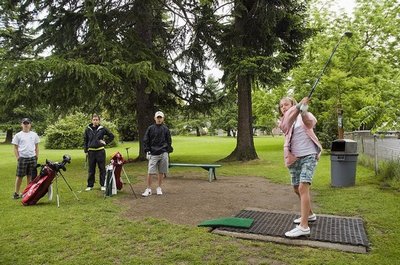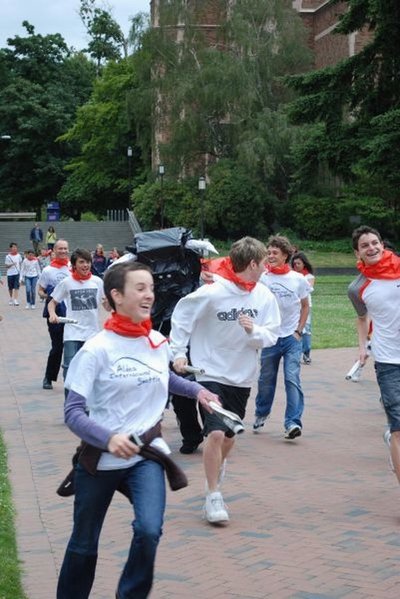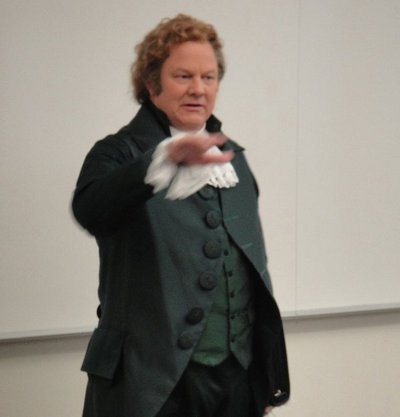July 8, 2010
Summer camps bring athletes, rockers, cheerleaders and more to the UW Seattle campus
Dozens of associations and camps come to the UW each summer, and this year is no exception. This season’s visitors include cheerleaders, student athletes, mathematicians, rock ‘n rollers, educators, Alexander Hamilton, bankers, bikers, tango dancers, young Native American leaders, salmon researchers and more.
And they’re all here to spend part of their summer — wait, Alexander Hamilton?
Well, close enough. The famous federalist himself died on July 12, 1804, from a pistol shot fired by Aaron Burr in a duel the day before. But his legacy lives on in the Alexander Hamilton Friends Association, which held Hamilton Leader Week 2010 at the UW from June 27 to July 2.
“This is our fourth year at the UW,” said Joslin Boroughs of the association, which brings students who are low-income but high achievers, as Hamilton himself was. “We work with students starting their junior year. Our goal is to support them in their journey to college and after, and help prepare them for the workplace.”
The Hamilton Friends got their camp started in style with a visit and presentation from Hamilton himself — actually actor and historical interpreter William Chrystal, who camp officials said did a great job portraying the founding father whose image appears on the 10-dollar bill.
The list of sports represented by student athletes visiting during the summer reads like a miniature Olympic Games. There’s football, baseball, basketball, lacrosse, soccer, volleyball, golf and cross-country. Biking will be represented, too, with the annual Seattle to Portland Classic taking off from the UW campus. And cheerleading is sort of a combination of the acrobatic and the artistic.
Music, dance and the arts will be handsomely represented, too. The Power Chord Academy takes teenage rockers from the wishing phase straight through recording a song and logging time in a band. Other young students will come to learn piano, and the UW Marching Band will have a late-summer residency as they practice up for the school year to come.
And again this year, there will be tango. That is, the Tango Magic Festival will return for “five beautiful days and summer nights of tango in Seattle,” as the group’s website states.
Language immersion is the essence of the Global Village summer Camps, which are spending much of July on campus. Anthony Geist, professor and chair of the Division of Spanish and Portuguese studies, said about 20 students have come from Spain to learn English and are being paired with area students wishing a similar immersion in Spanish.
“It’s an intercultural experience, where they learn about each other’s culture,” he said, adding, “they’re teenagers — they’re more interested in each other than in learning Spanish or English. But it’s wonderful to watch them find this common ground and begin to understand each other’s culture because they are understanding each other’s language.”
GEAR-UP, which stands for Gaining Early Awareness and Readiness for Undergraduate Programs, is well represented each summer. Also on the schedule is DO-IT, which promotes computer and networking technologies to help increase the academic and employment success of students with disabilities. And mid-August will see a weeklong Native Youth Leadership Camp.
The summer conference season begins just hours after spring quarter ends and it closes just before the new school year starts, making every summer a busy one for Leonard O’Connor, general manager in Housing & Food Services, and his team of conference coordinators. Sometimes they even have to do what they call a “same-day turn,” helping one group exit and another arrive and get settled all in the same day.
O’Connor said some of the conference coordinators are in touch all year with groups that wish to visit in the summer. “There’s a great deal of planning and logistics that have to come together,” he said. For a really large conference, planning “two or three years out would not be unusual,” he said. All in all, about 8,000 to 10,000 people come through every summer, which is down 15 or 20 percent from its peak a few years back.
Many groups are regulars that come to the UW every year, O’Connor said. But none has ever or will likely ever equal the attendance record of the Pacific Coast Banking School. This three-year program for mid- to upper-level banking executives has sent students to the UW campus for summer courses every year since 1938.



